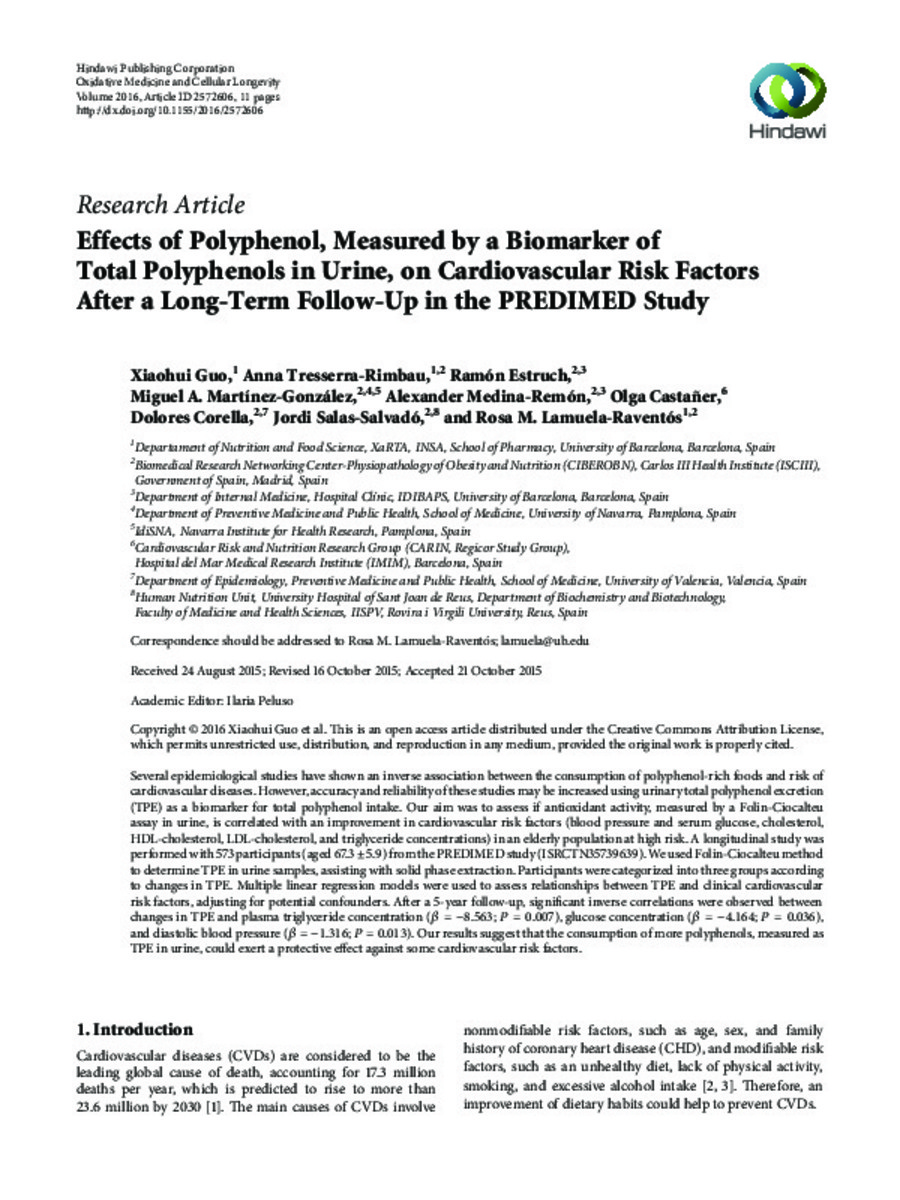Full metadata record
| DC Field | Value | Language |
|---|---|---|
| dc.creator | Lamuela-Raventos, R.M. (Rosa Maria) | - |
| dc.creator | Salas-Salvado, J. (Jordi) | - |
| dc.creator | Corella, D. (Dolores) | - |
| dc.creator | Castañer, O. (Olga) | - |
| dc.creator | Medina-Remon, A. (Alexander) | - |
| dc.creator | Martinez-Gonzalez, M.A. (Miguel Ángel) | - |
| dc.creator | Estruch, R. (Ramón) | - |
| dc.creator | Tresserra-Rimbau, A. (Anna) | - |
| dc.creator | Guo, X. (Xiaohui) | - |
| dc.date.accessioned | 2016-02-15T19:34:23Z | - |
| dc.date.available | 2016-02-15T19:34:23Z | - |
| dc.date.issued | 2016 | - |
| dc.identifier.citation | Xiaohui G, Tresserra-Rimbau A, Estruch R, Martinez-Gonzalez MA, Medina-Remon A, Castañer O, et al. Effects of Polyphenol, measured by a biomarker of total polyphenols in urine, on cardiovascular risk factors After a long-term follow-up in the PREDIMED study. Oxid Med Cell Longev 2016;2572606. | es_ES |
| dc.identifier.issn | 1942-0900 | - |
| dc.identifier.uri | https://hdl.handle.net/10171/39923 | - |
| dc.description.abstract | Several epidemiological studies have shown an inverse association between the consumption of polyphenol-rich foods and risk of cardiovascular diseases.However, accuracy and reliability of these studiesmay be increased using urinary total polyphenol excretion (TPE) as a biomarker for total polyphenol intake. Our aim was to assess if antioxidant activity, measured by a Folin-Ciocalteu assay in urine, is correlated with an improvement in cardiovascular risk factors (blood pressure and serum glucose, cholesterol, HDL-cholesterol, LDL-cholesterol, and triglyceride concentrations) in an elderly population at high risk. A longitudinal study was performedwith573participants (aged67.3 ± 5.9) fromthe PREDIMED study (ISRCTN35739639).We used Folin-Ciocalteumethod to determine TPE in urine samples, assisting with solid phase extraction. Participants were categorized into three groups according to changes in TPE. Multiple linear regression models were used to assess relationships between TPE and clinical cardiovascular risk factors, adjusting for potential confounders. After a 5-year follow-up, significant inverse correlations were observed between changes in TPE and plasma triglyceride concentration (𝛽 = −8.563; 𝑃 = 0.007), glucose concentration (𝛽 = −4.164; 𝑃 = 0.036), and diastolic blood pressure (𝛽 = −1.316; 𝑃 = 0.013). Our results suggest that the consumption of more polyphenols, measured as TPE in urine, could exert a protective effect against some cardiovascular risk factors. | es_ES |
| dc.description.sponsorship | Acknowledgments This study was supported by CICYT (AGL2013-49083- C3-1-R) from the Spanish Ministry of Economy and Competitiveness (MEC), the Generalitat de Catalunya (GC) 2014 SGR 773 and Instituto de Salud Carlos III, ISCIII (CIBEROBN). CIBEROBN is an initiative of ISCIII, Spain. Xiaohui Guo received support from China Scholarship Council (CSC). Alexander Medina-Rem´on thanks the “Juan de la Cierva” postdoctoral program (JCI-2012- 13463) from MEC. The Fundaci´on Patrimonio Comunal Olivarero (Madrid, Spain), California Walnut Commission (Sacramento, CA), Borges SA (Reus, Spain), and Morella Nuts SA (Reus, Spain) donated the olive oil, walnuts, almonds, and hazelnuts, respectively, used in the study. | es_ES |
| dc.language.iso | eng | es_ES |
| dc.publisher | Hindawi Publishing Corporation | es_ES |
| dc.relation | Morella Nuts SA (Reus, Spain) | - |
| dc.relation | California Walnut Commission (Sacramento, CA) | - |
| dc.relation | China Scholarship Council (CSC). | - |
| dc.relation | The Generalitat de Catalunya (GC) 2014 SGR 773 | - |
| dc.relation | This study was supported by CICYT (AGL2013-49083- C3-1-R) from the Spanish Ministry of Economy and Competitiveness (MEC) | - |
| dc.relation | Instituto de Salud Carlos III, ISCIII (CIBEROBN), Spain. | - |
| dc.relation | The Fundacion Patrimonio Comunal Olivarero (Madrid, Spain) | - |
| dc.relation | Borges SA (Reus, Spain) | - |
| dc.rights | info:eu-repo/semantics/openAccess | es_ES |
| dc.subject | Materias Investigacion::Ciencias de la Salud::Medicina preventiva | es_ES |
| dc.subject | PREDIMED study | es_ES |
| dc.subject | Long-term follow-up | es_ES |
| dc.subject | Cardiovascular risk factors | es_ES |
| dc.subject | Polyphenols in urine | es_ES |
| dc.subject | Biomarker | es_ES |
| dc.subject | Effects of Polyphenol | es_ES |
| dc.title | Effects of Polyphenol, measured by a biomarker of total polyphenols in urine, on cardiovascular risk factors After a long-term follow-up in the PREDIMED study | es_ES |
| dc.type | info:eu-repo/semantics/article | es_ES |
| dc.editorial.note | Copyright © 2016 Xiaohui Guo et al.This is an open access article distributed under the Creative Commons Attribution License, which permits unrestricted use, distribution, and reproduction in any medium, provided the original work is properly cited. | es_ES |
| dc.identifier.doi | http://dx.doi.org/10.1155/2016/2572606 | es_ES |
Files in This Item:
Statistics and impact
Items in Dadun are protected by copyright, with all rights reserved, unless otherwise indicated.






